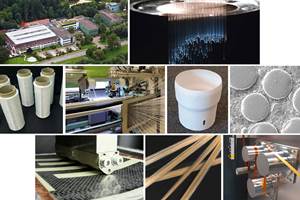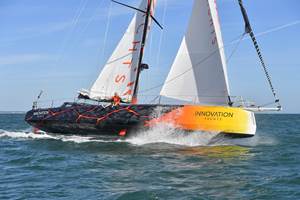Software shortens design path to longboard
Materials information program helps optimize materials selection.
When FORCE Technology (Brøndby, Denmark), a technology consultancy to the energy, oil and gas, maritime and manufacturing markets, wanted to teach its staff about composites, the challenge was how best to do it. To communicate which materials to use and how they should be combined to optimize their performance, composites specialist Benjamin Hornblow (on longboard in above photo) had his staff design a demonstration composite “longboard” skateboard. He turned for help to Granta Design (Cambridge, UK), a materials information technology firm founded 20 years ago as a spinoff from Cambridge University’s engineering department.
Hornblow employed Granta’s 2017 CES Selector software tool to quickly identify candidate materials and evaluate ways in which they could be combined to optimize results. The first
step was to investigate materials currently used in longboards and compare their performance. Although typical longboards feature maple, bamboo or composites, a state-of-the-art board, comprising a sandwich panel of carbon fiber on the bottom, maple in the core and glass fiber on the top, was used as a reference. The next step was to consider the performance of reinforcing fibers, the board’s main structural component. With Granta’s MaterialUniverse data product, the performance of five natural fibers — cotton, flax, hemp, jute and kenaf — was quickly compared/ contrasted with glass fiber, carbon fiber and aramid fiber.

Within CES Selector, Hornblow and sta could plot Young’s modulus and see that flax fibers lie within the same stiffness range as glass, but that both fall far below carbon fiber. Although natural fibers couldn’t compete with carbon or glass when tensile strength was plotted, their performance was deemed acceptable because longboard designs are stiffness-driven. When the fibers’ mechanical loss coefficients were compared, it was clear that the damping capability of flax fiber was three orders of magnitude greater than that of either glass or carbon fiber.
Hornblow then proposed a combination of carbon and flax fibers in
 a longboard to benefit from the stiffness of the former and damping properties of the latter. CES Selector’s Synthesizer Tool enabled him
 and his team to model the performance of the reference board and theoretical boards. Graphs were created in Selector to compare flexural modulus with density, using a performance index, so the team could easily identify materials that outperformed others. The CES graphs showed that a longboard made from a solid flax fiber/epoxy composite would be outperformed by a maple board, and that the reference board would perform no better than the one built with less-expensive bamboo.
Next, the team modeled the performance of a carbon fiber/PET foam-cored sandwich panel, and determined that this could lead to a large improvement over the bamboo and composite reference boards. Based on this, carbon and flax fiber were combined in a 7-layer cored panel model within CES Selector. Ultimately, it featured a 3-layer facesheet with carbon fiber twill as the outer layer, a uni carbon fiber layer, then a layer of biaxial flax fabric, with a PET foam core. The final design plot showed a big improvement over previous iterations. The design was refined in Dassault Systèmes’ (Waltham, MA, US) CATIA 3D CAD program, then prototyped and tested. The final longboard, slightly thicker than the reference and slightly less stiff in three-point bending, was 30% lighter, providing greater acceleration and a smoother, more enjoyable ride.
Says Hornblow, “It was great to use the multilayer Synthesizer Tool in CES Selector to ‘test out’ different materials, concepts and configurations early in the design process. This saved valuable time by reducing the number of iterations required for the more labor-intensive CAD modeling and prototyping stages.” Notably, FORCE Technology is workingb
with a US skateboard start-up to revise the prototype, using a higher percentage of sustainable materials.
Related Content
DITF Denkendorf advances sustainable carbon fibers, oxide fibers for CMC and more
The German Institutes of Textile and Fiber Research are targeting more sustainable carbon fiber via low-pressure stabilization and bio-based precursors, and working with Saint-Gobain to commercialize oxide ceramic fibers for CMC.
Read MoreJEC World 2025 highlights: Evolving recycling and biomaterials technologies
CW technical editor Hannah Mason shares sustainability-focused composites trade show highlights featuring maturation, scale-up, new partnerships, and new technologies in biomaterials and recycling.
Read MoreNotox surfboards harness flax fiber for wave surfing competition
Libeco flax, Airbus rCF fabrics, Sicomin GreenPoxy bioresins and an agave core form a heavy, robust surfboard custom-designed for Clément Roseyro in this year’s Nazaré Big Waves Surf event.
Read MoreEuropean boatbuilders lead quest to build recyclable composite boats
Marine industry constituents are looking to take composite use one step further with the production of tough and recyclable recreational boats. Some are using new infusible thermoplastic resins.
Read MoreRead Next
Scaling up, optimizing the flax fiber composite camper
Greenlander’s Sherpa RV cab, which is largely constructed from flax fiber/bio-epoxy sandwich panels, nears commercial production readiness and next-generation scale-up.
Read MoreUltrasonic welding for in-space manufacturing of CFRTP
Agile Ultrasonics and NASA trial robotic-compatible carbon fiber-reinforced thermoplastic ultrasonic welding technology for space structures.
Read MoreCutting 100 pounds, certification time for the X-59 nose cone
Swift Engineering used HyperX software to remove 100 pounds from 38-foot graphite/epoxy cored nose cone for X-59 supersonic aircraft.
Read More












